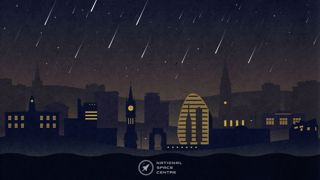
Northern Taurid Meteor Shower
- 30th Oct 2025
- Author: Team Discovery (edited: Dhara Patel)
Join stargazers across the globe to gaze upon the annual Northern Taurid meteor shower this November. Catch the peak on 12 November 2025.
The radiant of this meteor shower appears to come from the direction of the constellation of Taurus. The best time to view the Northern Taurid meteor shower will be around midnight when the shower’s radiant will be highest in the sky. It is one of the weaker showers of the year with a rate of only 5 meteors per hour in ideal conditions. Due to the time of year, they are sometimes known as Halloween fireballs.
How to watch from the UK
To watch the Northern Taurid meteor shower, face towards the constellation of Taurus the bull. Make sure to not only look at Taurus, as meteors closer to the radiant have shorter trails so will be more difficult to spot. Scan the skies to catch shooting stars with the most brilliant trails.
The Taurids are actually split into two showers - the Northern Taurids and Southern Taurids, caused by two parts of the same field of 'comet crumbs'. While the Southern Taurids peak around 5 November, the Northern Taurids this year is set to peak during the morning 12 November. With the Moon in its last quarter phase, moonlight interference will create less than ideal viewing conditions throughout much of the night.
Still, as the Taurids tend to be larger than other meteors and also travel rather slowly, surviving for longer periods as they pass through Earth's atmosphere, they're worth trying to spot. And while the peak is the ideal time to try and catch them, they're active between late October and early December.
Taurus will appear in the southern sky late in the evening. It can be found beside the constellation of Orion, with the red star Aldebaran marking the eye of the bull.
Find a dark sky area, wrap up warm, and allow 20 minutes for your eyes to adjust and then scan the skies to enjoy the shooting stars using only the optical tool that nature gave you – your eyes. Meteors are usually too quick and appear all over the sky making them very difficult to view in binoculars or telescopes that have a small field of view.
What is a meteor shower?
Meteor showers occur when the Earth passes through the debris of a comet. The dust and gas left behind by the comet burn up in the atmosphere causing a shooting star or meteor.
The object responsible for the Northern Taurid meteor shower is thought to be the asteroid 2004 TG10 - a possible large fragment of comet Encke, which is responsible for producing the Southern Taurids. Comet Encke is a small comet whose debris (ice and dust) produces infrequent, slow, and long-lasting meteors.
The debris stream is quite spread out, so it takes the Earth a while to pass through. That’s why both Taurid showers are active for a relatively long period of time: the Southern Taurids between 10 September and 20 November, and the Northern Taurids between 20 October and 10 December. Because the debris stream has two fragments, we get the two showers with roughly the same peak rates.
Meteor Infographic
Download our National Space Centre Meteor Shower Guide to make sure you are fully prepared!
Upcoming meteor showers for 2025 include:
Leonids
Comet of Origin: 55P/Tempel-Tuttle
Radiant: constellation Leo
Peak Activity: 17-18 November 2025
Peak Activity Meteor Count: up to 10 meteors per hour
Geminids
Asteroid of Origin: 3200 Phaethon
Radiant: constellation Gemini
Peak Activity: 13-14 December 2025
Peak Activity Meteor Count: up to 150 meteors per hour
Ursids
Comet of Origin: 8P/Tuttle
Radiant: constellation Ursa Minor
Peak Activity: 22-23 December 2025
Peak Activity Meteor Count: up to 10 meteors per hour
Happy meteor-gazing!
Full references / credits:
(Banner image) Meteor showers. Credit: © National Space Centre
(1) Radiant of the Taurids. Credit: Stellarium
(2) Taurid Meteor Shower - Joshua Tree, California, 6 November 2015. Credit: Channone Arif CC BY 2.0 DEED (https://commons.wikimedia.org/wiki/File:Taurid_Meteor_Shower_-_Joshua_Tree,_California_-_6_Nov._2015.jpg)




